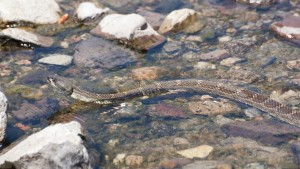
Rattlesnakes have always inspired our imaginations, from Native American cultures who have depicted them in their art and religions, to portrayals in Westerns as villainous, bad-tempered animals. But despite some popularly held beliefs about rattlesnakes’ supposed bad behavior, this is not usually the case. People aren't on the rattlesnakes' prey list. If they strike anyone, it’s usually a defensive maneuver – such as when they’re accidentally stepped on. And the majority of rattlesnake bites that occur in the United States are received by young men who tease a rattlesnake (and yes, alcohol is often involved in these instances). So for the majority of us who would never consider playing with a rattlesnake, there's relatively very little danger. It is important, however, to watch where you walk or put your hands when spending time in rattlesnake country. They’re not always vocal with their telltale rattle sound and blend in easily with their environment.
Katie Colbert, a naturalist at Sunol-Ohlone Regional Wilderness, has often heard people warn that a baby rattlesnake is a greater threat due to the fact that they're unable to control the amount of poison they inject into their victim when they bite. According to Colbert, this is just not true: all rattlesnakes, babies and adults, can control their venom. In addition, Colbert says, "Baby rattlesnakes can only produce and stash a very small fraction of [venom] an adult can." This does not change the fact, however, that a bite from any rattlesnake, regardless of age, is a dangerous bite and requires medical attention.
Another myth is that a rattlesnake's tail can be used to determine the age of the animal. The origin of this misconception that each segment of the rattle corresponds to a year of the snake’s life can be traced back to English writer Thomas Morton, author of the book, New English Canaan, that was published in 1637. According to the website, Daily Reptile News, we now understand that every time rattlesnakes shed their skin, they add a segment to their rattle. They can shed anywhere from one to three times a year, and the rattles often break off in the normal daily lives of the snakes.
And what should you do if you've been bitten by a rattlesnake? The California Poison Control Systems website offers some helpful guidance:
- A tourniquet should never be applied to the limb with the bite wound. This can cause gangrene to form and amputation may become necessary.
- Bite wounds should never be cut open with a knife or razor. The extra blood flow is not only bad for the injured victim, but it can also spread the venom throughout the body more quickly.
- Sucking out the poison is also a bad idea, as it will not extract all of the venom. Bacteria from the person's mouth could also transmit bacteria to the wound that could exacerbate the risk of infection.
- While keeping the victim calm and still, wash the wound with soap and water, keep the wound below the heart, and get them emergency medical attention as soon as possible.
Although they are potentially dangerous animals, rattlesnakes tend to keep to themselves and only really become aggressive when provoked or cornered. As they are an important part of the ecosystem, it's best to just allow them plenty of room and safe passage when encountered in the wild so they can continue to do their part for the animal kingdom: control the population of rodents and provide food to the predators that feed on them.